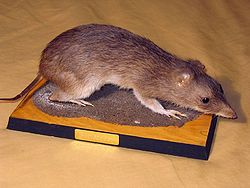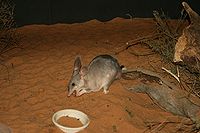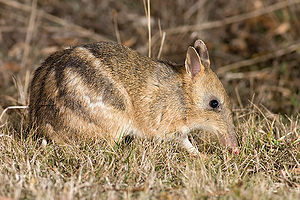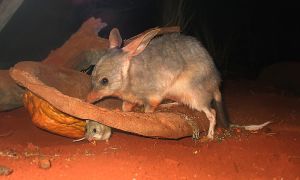Difference between revisions of "Peramelemorphia" - New World Encyclopedia
Rick Swarts (talk | contribs) |
Rick Swarts (talk | contribs) |
||
| Line 182: | Line 182: | ||
*{{MSW3 Groves|pages=38-42}} | *{{MSW3 Groves|pages=38-42}} | ||
** [http://www.bucknell.edu/msw3/browse.asp?s=y&id=10900001 Peramelemorphia] | ** [http://www.bucknell.edu/msw3/browse.asp?s=y&id=10900001 Peramelemorphia] | ||
| + | |||
| + | http://animaldiversity.ummz.umich.edu/accounts/Peramelemorphia/ | ||
| + | |||
| + | http://animaldiversity.ummz.umich.edu/accounts/Peramelidae/ | ||
| + | |||
| + | http://animaldiversity.ummz.umich.edu/accounts/Thylacomyidae/classification/ | ||
| + | |||
{{Mammals}} | {{Mammals}} | ||
Revision as of 22:43, 18 March 2014
| Peramelemorphia
| ||||||||||||
|---|---|---|---|---|---|---|---|---|---|---|---|---|
 A short-nosed bandicoot (Isoodon spp.)
| ||||||||||||
| Scientific classification | ||||||||||||
| ||||||||||||
|
†Yaralidae |
The order Peramelemorphia includes the bandicoots and bilbies: it equates approximately to the mainstream of marsupial omnivores. All members of the order are endemic to the twin land masses of Australia-New Guinea and most have the characteristic bandicoot shape: a plump, arch-backed body with a long, delicately tapering snout, very large upright ears, relatively long, thin legs, and a thin tail. Their size varies from about 140 grams up to 4 kilograms,[1] but most species are about the weight of a half-grown kitten: somewhere around one kilogram.
Phylogeny
Placement within Marsupialia
The position of the Peramelemorphia within the marsupial family tree has long been puzzling and controversial. There are two morphological features in the order that appear to show a clear evolutionary link with another marsupial group: the type of foot, and the teeth. Unfortunately, these clear signposts point in opposite directions.[2]
All members of the order are polyprotodont (have several pairs of lower front teeth)—in the case of the Peramelemorphia, three pairs. This suggests that they have evolved within Dasyuromorphia (marsupial carnivores). On the other hand, they also have an unusual feature in their feet: the second and third toes are fused together. This condition is called syndactyly, and is characteristic of the Diprotodontia (the order of marsupial herbivores that includes kangaroos, wombats, possums, and many others).[3]
Attempts to resolve this puzzle include the view that the bandicoot group evolved from the carnivores, retaining the polyprotodont dentition, and independently evolving a syndactyl hind foot; the contrary view that syndactyly is so unusual that it is unlikely to have evolved twice and therefore the bandicoot group must have evolved from a possum-like diprotodont creature, and re-evolved its extra teeth. A third view suggests that the bandicoot group evolved from a primitive carnivore, developed the syndactylous hind foot as a specialisation for climbing, and the diprotodonts then split off and evolved the two-tooth jaw that gives them their name. Recent molecular level investigations do not so far appear to have resolved the puzzle, but do strongly suggest that whatever the relationship of the bandicoot group to the other marsupial orders may be, it is a distant one.[4]
Relationships within Peramelemorphia
Recent molecular analyses have resulted in a phylogenetic reconstruction of the members of Peramelemorphia with quite strong support. The most basal split separates Thylacomyidae (Macrotis) from all other bandicoots. Probably the next to diverge was the recently extinct Chaeropodidae (Chaeropus). The remaining taxa comprise the Peramelidae, which divides into subfamilies Peramelinae (Isoodon and Perameles) and a clade in which the Echymiperinae (Echymipera and Microperoryctes) form a sister group to Peroryctinae (Peroryctes):[4]
| Peramelemorphia |
| ||||||||||||||||||||||||||||||||||||
Fossil record
Many specimens of modern peramelemorphian (e.g. Perameles spp. and Isoodon spp.) have been recovered in the fossil record from Pleistocene and Holocene fossil localities.[5] However, very few fossil species have been recovered to date. The first species of fossil peramelemorphian was described by R. A. Stirton in 1955. The specimen Stirton described was a partial lower jaw from the Tirari Desert in Central Australia, Pliocene in age. The lower jaw morphology suggested a relationship with bilbies (Family Thylacomyidae), and was named Ischnodon australis.[6]
It is not until 1976 that Archer and Wade described the next fossil bandicoot. A single upper molar was recovered from the Bluff Downs fossil site, Allingham Formation, in northern Queensland, also Pliocene in age. The tooth was similar to that of species of Perameles, hence why it was named Perameles allinghamensis.[7]
In 1995, the first Miocene species was described from Riversleigh, and was named Yarala burchfieldi by Dr Jeannette Muirhead. The species was represented by several upper and lower jaws, which were smaller than any living bandicoots and had a very primitive dentition.[8] A skull was later recovered in 2000, the first for any fossil peramelemorphian to date. Features of the skull and dentition suggested that Yarala burchfieldi was distinct from other peramelemorphians, and for this reason, a new Superfamily Yaraloidea and Family Yaralidae were erected to classify this species.[9]
In 1997, Muirhead, Dawson and Archer described a new species of Perameles, Perameles bowensis, from teeth recovered from two Pliocene fossil localities, Bow and Wellington Caves.[10] The same species was later reported in 2000 from Chinchilla, Queensland by Mackness and colleagues.[11] In 2002, Price described a new species Perameles, Perameles sobbei, from the Darling Downs (Pleistocene in age), south-eastern Queensland. This species was represented by a lower jaw and a few isolated lower molars.[12] Additional material were later described in 2005 from the same site, including upper molars.[13]
A second species of Yarala, Yarala kida, was described in 2006 by Schwartz. This species was recovered from Kangaroo Well, a late Oligocene site from the Northern Territory in Australia. This species is thought to be even more primitive than Yarala burchfieldi.[14]
The second fossil skull of any fossil peramelemorphian was also recovered from Miocene sites of Riversleigh. In fact, more than one skull of this new species was found (and several lower and upper jaws), and was significantly different from any other bandicoot to erect a new genus, Galadi. The species was named Galadi speciosus by Travouillon and colleagues. It was short-snouted unlike modern bandicoots suggesting that it was more carnivorous than its omnivorous modern relatives. Its relationship to other bandicoots is unclear, but it was likely to be less primitive than Yarala but more primitive than living bandicoots.[15] An additional three species of Galadi were later described in 2013 and named Galadi grandis, Galadi amplus and Galadi adversus.[16]
Gurovich et al. (2013) described a new species of mouse-sized bandicoot from Riversleigh (Queensland) and Kutjamarpu (Southern Australia). The species, named Bulungu palara, is represented by a skull and several lower and upper jaws.[17] Two other species in this genus were also described from the Etadunna Formation in South Australia, Bulungu muirheadae which is the oldest fossil bandicoot recovered to date (about 24 million years old), and Bulungu campbelli.[18]
Bandicoot
Bandicoots are a group of about 20 species of small to medium-sized, terrestrial marsupial omnivores in the order Peramelemorphia. They are endemic to Australia.
Etymology
The word itself is often used as a common name for any of them, and is an anglicised form of the Telugu word పందికొక్కు (pandi-kokku), loosely, pig-rat.[19] which originally referred to the unrelated Indian Bandicoot Rat. The other two species of peramelemorphs are the bilbies.
Characteristics
They are one of the few species that have a bifurcated penis.[20]
The embryos of bandicoots, unlike other marsupials, form a placenta-like organ that connects it to the uterine wall.[21] The function of this organ is probably to transfer nutrients from the mother; however the structure is small, compared to those of the Placentalia.
They may also serve as a primary reservoir for Coxiella burnetii. Infection is transmitted among them by ticks. These are then transmitted to domestic animals (cattle, sheep and poultry). The infected domestic animals shed them in urine, faeces, and placental products. It is transmitted to humans causing Q fever by inhalation of aerosols of these materials. Main symptoms may be pneumonia and/or hepatitis.
Classification
Classification within the Peramelemorphia used to be simple. There were thought to be two families in the order—the short-legged and mostly herbivorous bandicoots, and the longer-legged, nearly carnivorous bilbies. In recent years, however, it has become clear that the situation is more complex. First, the bandicoots of the New Guinean and far-northern Australian rainforests were deemed distinct from all other bandicoots and were grouped together in the separate family Peroryctidae. More recently, the bandicoot families were reunited in Peramelidae, with the New Guinean species split into four genera in two subfamilies, Peroryctinae and Echymiperinae, while the "true bandicoots" occupy the subfamily Peramelinae. The only exception is the now extinct Pig-footed bandicoot, which has been given its own family, Chaeropodidae.
- Order Peramelemorphia
- Unclassified fossil bandicoots
- Superfamily Perameloidea[26]
- Family Thylacomyidae
- Genus Macrotis: 2 species
- Genus †Ischnodon: 1 species[27]
- Family †Chaeropodidae: Pig-footed bandicoot
- Genus †Chaeropus: 1 species
- Family Peramelidae
- Subfamily Peramelinae
- Genus Isoodon: short-nosed bandicoots
- Genus Perameles: long-nosed bandicoots
- Subfamily Peroryctinae
- Genus Peroryctes: New Guinean long-nosed bandicoots
- Subfamily Echymiperinae
- Genus Echymipera: New Guinean spiny bandicoots
- Genus Microperoryctes: New Guinean mouse bandicoots
- Genus Rhynchomeles: Ceram Bandicoot
- Subfamily Peramelinae
- Family Thylacomyidae
- Superfamily †Yaraloidea
- Family †Yaralidae
- Genus †Yarala: 2 species
- Family †Yaralidae
Bilby
Template:Italic title
| Bilby | ||||||||||||||
|---|---|---|---|---|---|---|---|---|---|---|---|---|---|---|
 Greater bilby at Monarto Zoo
| ||||||||||||||
| Scientific classification | ||||||||||||||
| ||||||||||||||
| Perameles lagotis Reid, 1837 | ||||||||||||||
|
Macrotis lagotis |
Bilbies are desert-dwelling marsupial omnivores; they are members of the order Peramelemorphia. Before European colonisation of Australia, there were two species. One became extinct in the 1950s; the other survives but remains endangered.
Etymology of "bilby"
The term bilby is a loanword from the Yuwaalaraay Aboriginal language of northern New South Wales, meaning long-nosed rat. It is known as dalgite in Western Australia, and the nickname pinkie is sometimes used in South Australia.[28] The Wiradjuri of New South Wales also call it "bilby".[29]
Characteristics
Bilbies have the characteristic long bandicoot muzzle and very long ears. They are about 29–55 cm in length. Compared to bandicoots, they have a longer tail, bigger ears, and softer, silky fur. The size of their ears allows them to have better hearing as well. They are nocturnal omnivores that do not need to drink water, as they get all the moisture they need from their food, which includes insects and their larvae, seeds, spiders, bulbs, fruit, fungi, and very small animals. Most food is found by digging or scratching in the soil, and using their very long tongues.
Unlike bandicoots, they are excellent burrowers and build extensive tunnel systems with their strong forelimbs and well-developed claws. A bilby typically makes a number of burrows within its home range, up to about a dozen; and moves between them, using them for shelter both from predators and the heat of the day. The female bilby's pouch faces backwards, which prevents her pouch from getting filled with dirt while she is digging.
Bilbies have a very short gestation period of about 12 – 14 days, one of the shortest among mammals.[30]
Conservation
Bilbies are slowly becoming endangered because of habitat loss and change as well as the competition with other animals. There is a national recovery plan being developed for saving these animals: this program includes breeding in captivity, monitoring populations, and reestablishing bilbies where they once lived. There have been reasonably successful moves to popularise the bilby as a native alternative to the Easter Bunny by selling chocolate Easter Bilbies (sometimes with a portion of the profits going to bilby protection and research). Reintroduction efforts have also begun, with a successful reintroduction into the Arid Recovery Reserve in South Australia in 2000,[31] and plans underway for a reintroduction into Currawinya National Park in Queensland,[32] with a recent success with six bilbies released into the feral-free sanctuary in early February 2006.
Successful reintroductions have also occurred onto Peron Peninsula in Western Australia as a part of [33] Western Shield. Successful reintroductions have also occurred on other conservation lands, including islands and the Australian Wildlife Conservancy's[34] Scotia[35] and Yookamurra Sanctuaries.[36] There is a highly successful bilby breeding program at Kanyana Wildlife Rehabilitation Centre,[37] near Perth, Western Australia.
Classification
The placement of bilbies within the Peramelemorphia has changed in recent years. Vaughan (1978) and Groves and Flannery (1990) both placed this family within the Peramelidae family. Kirsch et al. (1997) found them to be distinct from the species in Peroryctidae (which is now a subfamily in Peramelidae). McKenna and Bell (1997) also placed it in Peramelidae, but as the sister of Chaeropus in the subfamily Chaeropodinae.[38]
Species
- Genus Macrotis
- Greater bilby, M. lagotis
- Lesser bilby, †M. leucura
- Genus †Ischnodon
- †Ischnodon australis[39]
- Genus †Liyamayi
- †Liyamayi dayi[40]
ReferencesISBN links support NWE through referral fees
- ↑ Aplin, K.P., Helgen, K.M., Lunde, D.P., 2010. A review of Peroryctes broadbenti, the giant bandicoot of Papua New Guinea. . American Museum novitates 3696, 1-41.
- ↑ Gordon, G., Hulbert, A.J., 1989. Peramelidae, In: Walton, D.W. (Ed.), Fauna of Australia. . Australian Government Publishing Service, Canberra, pp. 603–624.
- ↑ Strahan, R. 1995. Mammals of Australia. Washington, D.C.: Smithsonian Institution Press.
- ↑ 4.0 4.1 Meredith, Robert W.; Westerman, Michael; Springer, Mark S. (2008). A timescale and phylogeny for "Bandicoots" (Peramelemorphia: Marsupialia) based on the sequences for five nuclear genes. Molecular Phylogenetics and Evolution 47 (1): 1–20.
- ↑ Rich, T. H, Archer, M., Hand, S. J., Godthelp, H., Muirhead, J., Pledge, N. S., Flannery, T. F., Woodburne, M. O., Case, J. A., Teford, R. H., Turnbull, W. D., Lundelius, E. L.jr., Rich, L. S. V., Whitelaw, M. J., Kemp, A., & Rich, P. V. 1991. Australian Mesozoic and Tertiary terrestrial mammal localities, Appendix 1. Pp. 1005-1058 in P. Vickers-Rich, Monaghan J. M., R. F. Baird & T. H. Rich (eds), Vertebrate Palaeontology of Australia. Pioneer Design Studio and Monash University Publications Commiitee, Melbourne.
- ↑ Stirton, R. A. 1955. Late Tertiary marsupials from South Australia. Records of the South Australian Museum, 11, 247– 267.
- ↑ Archer, M. & Wade, M. 1976. Results of the Ray E. Lemley expeditions, part 1: The Allingham Formation and a new Pliocene vertebrate fauna from northern Queensland. Memoirs of the Queensland Museum, 17, 54–58.
- ↑ Muirhead, J. & Filan, S. L. 1995. Yarala burchfieldi, a plesiomorphic bandicoot (Marsupialia, Peramelemorphia) from Oligo-Miocene deposits of Riversleigh, northwestern Queensland. Journal of Paleontology, 69(1), 127-134.
- ↑ Muirhead, J. 2000. Yaraloidea (Marsupialia, Peramelemorphia), a new superfamily of marsupial and a description and analysis of the cranium of the Miocene Yarala burchfieldi. Journal of Paleontology, 74(3), 512-523.
- ↑ Muirhead, J., Dawson, L. & Archer, M. 1997. Perameles bowensis, a new species of Perameles (Peramelomorphia, Marsupialia) from Pliocene faunas of Bow and Wellington caves, New South Wales. Proceedings of the Linnean Society of New South Wales, 17, 163–174.
- ↑ Mackness, B. S., Wroe, S., Muirhead, J., Wilkinson, C. & Wilkinson, D. 2000. First fossil bandicoot from the Pliocene Chinchilla Local Fauna. Australian Mammalogy, 22, 133– 136.
- ↑ Price, G. J. 2002. Perameles sobbei, sp. nov. (Marsupialia, Peramelidae), a Pleistocene bandicoot from the Darling Downs, south-eastern Queensland. Memoirs of the Queensland Museum, 48, 193-197.
- ↑ Price, G. J. 2005. Fossil bandicoots (Marsupialia, Peramelidae) and environmental change during the Pleistocene on the Darling Downs, southeastern Queensland, Australia. Journal of Systematic Palaeontology, 4, 347-356.
- ↑ Schwarz, L. R. S. 2006. A new species of bandicoot from the Oligocene of northern Australia and implications of bandicoots for correlating Australian Tertiary mammal faunas. Palaeontology, 49, 991–998.
- ↑ K.J. Travouillon; Y. Gurovich; R.M.D. Beck; J. Muirhead (2010). "An exceptionally well-preserved short-snouted bandicoot (Marsupialia; Peramelemorphia) from Riversleigh's Oligo-Miocene deposits, northwestern Queensland, Australia". Journal of Vertebrate Paleontology 30 (5): 1528–1546. doi:10.1080/02724634.2010.501463
- ↑ K. J. Travouillon, Y. Gurovich, M. Archer, S. J. Hand and J. Muirhead (2013). "The genus Galadi: three new bandicoots (Marsupialia, Peramelemorphia) from Riversleigh’s Miocene deposits, northwestern Queensland, Australia". Journal of Vertebrate Paleontology 33 (1): 153–168. doi:10.1080/02724634.2012.713416
- ↑ Gurovich, Y., Travouillon, K.J., Beck, R.M.D., Muirhead, J., Archer, M., 2013. Biogeographical implications of a new mouse-sized fossil bandicoot (Marsupialia: Peramelemorphia) occupying a dasyurid-like ecological niche across Australia. Journal of Systematic Palaeontology.
- ↑ Travouillon, K.J., Beck, R.M.D., Hand, S.J., Archer, M., 2013b. The oldest fossil record of bandicoots (Marsupialia; Peramelemorphia) from the late Oligocene of Australia. Palaeontologia Electronica 16, 13A 52p.
- ↑ Definition of bandicoot from the Merriam-Webster Online Dictionary. Retrieved 7 September 2011.
- ↑ Natural History Collections: Anatomical Differences. Nhc.ed.ac.uk. Retrieved 2014-03-07.
- ↑ George A. Feldhamer (2007). Mammalogy: adaptation, diversity, ecology. JHU Press. ISBN 978-0-8018-8695-9. Retrieved 7 September 2011.
- ↑ K.J. Travouillon; Y. Gurovich; R.M.D. Beck; J. Muirhead (2010). "An exceptionally well-preserved short-snouted bandicoot (Marsupialia; Peramelemorphia) from Riversleigh's Oligo-Miocene deposits, northwestern Queensland, Australia". Journal of Vertebrate Paleontology 30 (5): 1528–1546. doi:10.1080/02724634.2010.501463
- ↑ K. J. Travouillon, Y. Gurovich, M. Archer, S. J. Hand and J. Muirhead (2013). "The genus Galadi: three new bandicoots (Marsupialia, Peramelemorphia) from Riversleigh’s Miocene deposits, northwestern Queensland, Australia". Journal of Vertebrate Paleontology 33 (1): 153–168. doi:10.1080/02724634.2012.713416
- ↑ Gurovich, Y., Travouillon, K.J., Beck, R.M.D., Muirhead, J., Archer, M., 2013. Biogeographical implications of a new mouse-sized fossil bandicoot (Marsupialia: Peramelemorphia) occupying a dasyurid-like ecological niche across Australia. Journal of Systematic Palaeontology.
- ↑ Travouillon, K.J., Beck, R.M.D., Hand, S.J., Archer, M., 2013b. The oldest fossil record of bandicoots (Marsupialia; Peramelemorphia) from the late Oligocene of Australia. Palaeontologia Electronica 16, 13A 52p.
- ↑ Strahan, R. 1995. Mammals of Australia. Washington, D.C.: Smithsonian Institution Press.
- ↑ Stirton, R.A., 1955. Late tertiary marsupials from South Australia. Records of the South Australian Museum 11, 247-268.
- ↑ http://www.anu.edu.au/andc/res/aewords/aewords_ab.php
- ↑ http://www.kasei.ac.jp/library/kiyou/2001/13.YOKOSE.pdf
- ↑ Gordon, Greg (1984). in Macdonald, D.: The Encyclopedia of Mammals. New York: Facts on File, 846–849. ISBN 0-87196-871-1.
- ↑ Moseby K. E. and O'Donnell E. O. (2003) Reintroduction of the greater bilby, Macrotis lagotis (Reid) (Marsupialia: Thylacomyidae), to northern South Australia: survival, ecology and notes on reintroduction protocols Wildlife Research 30, 15-27.
- ↑ Queensland Government (2004) Save The Bilby Appeal
- ↑ Western Australian Department of Environment and Conservation 'Project Eden'
- ↑ Australian Wildlife Conservancy
- ↑ Australian Wildlife Conservancy Scotia Sanctuary
- ↑ Australian Wildlife Conservancy Yookamurra Sanctuary
- ↑ Kanyana Wildlife Rehabilitation Centre (Inc.)
- ↑ C. Groves, "Order Primates," "Order Monotremata," (and select other orders). Page(s) 38 in D. E. Wilson and D. M. Reeder, eds., Mammal Species of the World, 3rd edition, Johns Hopkins University Press (2005). ISBN 0801882214.
- ↑ Stirton, R.A., 1955. Late tertiary marsupials from South Australia. Records of the South Australian Museum 11, 247-268.
- ↑ Travouillon, K.J., Hand, S. J., Archer, M., and Black, K. H., 2014. Earliest modern bandicoot and bilby (Marsupialia, Peramelidae and Thylacomyidae) from the Miocene of the Riversleigh World Heritage Area, northwestern Queensland, Australia. Journal of Vertebrate Paleontology 34:375-382.
- C. Groves, "Order Primates," "Order Monotremata," (and select other orders). Page(s) 38-42 in D. E. Wilson and D. M. Reeder, eds., Mammal Species of the World, 3rd edition, Johns Hopkins University Press (2005). ISBN 0801882214.
http://animaldiversity.ummz.umich.edu/accounts/Peramelemorphia/
http://animaldiversity.ummz.umich.edu/accounts/Peramelidae/
http://animaldiversity.ummz.umich.edu/accounts/Thylacomyidae/classification/
| Mammals |
|---|
| Monotremata (platypus, echidnas) |
|
Marsupialia: | Paucituberculata (shrew opossums) | Didelphimorphia (opossums) | Microbiotheria | Notoryctemorphia (marsupial moles) | Dasyuromorphia (quolls and dunnarts) | Peramelemorphia (bilbies, bandicoots) | Diprotodontia (kangaroos and relatives) |
|
Placentalia: Cingulata (armadillos) | Pilosa (anteaters, sloths) | Afrosoricida (tenrecs, golden moles) | Macroscelidea (elephant shrews) | Tubulidentata (aardvark) | Hyracoidea (hyraxes) | Proboscidea (elephants) | Sirenia (dugongs, manatees) | Soricomorpha (shrews, moles) | Erinaceomorpha (hedgehogs and relatives) Chiroptera (bats) | Pholidota (pangolins)| Carnivora | Perissodactyla (odd-toed ungulates) | Artiodactyla (even-toed ungulates) | Cetacea (whales, dolphins) | Rodentia (rodents) | Lagomorpha (rabbits and relatives) | Scandentia (treeshrews) | Dermoptera (colugos) | Primates | |
Template:Peramelemorphia
Credits
New World Encyclopedia writers and editors rewrote and completed the Wikipedia article in accordance with New World Encyclopedia standards. This article abides by terms of the Creative Commons CC-by-sa 3.0 License (CC-by-sa), which may be used and disseminated with proper attribution. Credit is due under the terms of this license that can reference both the New World Encyclopedia contributors and the selfless volunteer contributors of the Wikimedia Foundation. To cite this article click here for a list of acceptable citing formats.The history of earlier contributions by wikipedians is accessible to researchers here:
The history of this article since it was imported to New World Encyclopedia:
Note: Some restrictions may apply to use of individual images which are separately licensed.


